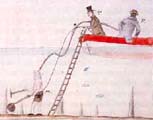Submerged structures / Lake dwellings

Submerged settlement in the Zürich Lake
investigated in 1854 by Forel, Morlot, and Troyon. |
The sea level in the world's oceans has remained nearly unchanged during the last 1000 years or
more. One exception is the middle and north Baltic Sea, where the sea-bottom
is rising. Remains of ancient dwellings or cities
can be found underwater for various reasons:
A: The sea level may have risen locally, like the Swedish Vättern lake, as well as
in Denmark or the La Tène and Charavines lake settlements in Switzerland.
B: The dwellings may have been built on water. Examples are the Bulverket
fortification and the crannogs of Ireland and Scotland.
C: The land has sunk after seismic activity (not in northern Europe).
D: Landslides or floods may have eroded or washed buildings into the sea.
Various lakeside dwellings
-
Tybrind Vig,
Denmark. Submerged stone-age settlement from c 5500-4000 BC, now located on ca 2 m depth. This
was a large investigation project for more than 10 years involving archaeologists and volunteer
scuba divers. Among the finds were log boats, tools and weapons.
-
Ronæs Skov, Gamborg Fjord,
Denmark. Submerged stone-age settlement from c 4000 f Kr. Ref
Fortidsminder og kulturhistorie (Skov- og Naturstyrelsen 1987)
-
La
Marmotta, Italy. Submerged settlement from ca 5700 BC, abandoned
ca 5200 BC. Among the finds is one 10 m long logboat.
- Black Sea mesolitic settlement. Stone-age settlement found in 2000 by the Robert Ballard
team, on 95 m depth off the Turkish coast. The site seems to
be from before the flood, at least 7000 years old. More
info.
- Submerged settlement in the Bay of Wismar, Harald Lübke, Germany.
Remains of dwelling from c 2000 BC, now submerged
 . .
- Dvaraka/Dwarka, India. Remains of
ancient port and settlements
from 1500-1400 BC and later, submerged or washed away in the Arabian
Sea. Investigated since 1979. Photo courtesy National Institute of Oceanography, Goa, India. Ref British Museum Encyclopaedia of
Underwater and Maritime Archaeology.
- Colletière,
Medieval lake settlement, France. Partly submerged after water level
rise.
Pile dwellings & crannogs
- Alvastra
pile-dwelling, National History Museum, Sweden. Dated to c 3100
BC.

- Scottish Crannog Centre
- Archäologische
Kulturdenkmale und Denkmalschutz am Bodensee, Helmut Schlichtherle. Maritime cultural
heritage in Lake Constance, Germany/Switzerland.
- Submerged settlement in the
Zürich Lake, Switzerland. In 1854 the water level of the Zürich Lake
was particularly low. Remains of pile dwellings were discovered and investigated.
Since then, remains of hundreds of lakeside settlements have been located under
water in Switzerland. The settlements were built in marshy areas during 4300 - 800
BC, and submerged much later due to raising water levels.
- Pfahlbaumuseum Unteruhldingen,
pile dwellings in Lake Constance (Bodensee),
Germany.
- La Tène, prehistoric Celtic
pile dwelling, located in 1857, Switzerland. The site was submerged by later sea level rise.
The original buildings may have been at the shore rather than in the water.
- Bulverket fortification, Gotland, Sweden.
Mysterious Medieval c 170x170 m square shaped fortification in a lake, apparently
never used and abandoned shortly
after construction in the 1130s AD. Several houses and three boats have been found.
Various submerged structures
- Cosquer
Cave, near Marseilles, France. Discovered in 1991 or '92, partially submerged cave with stone-age
paintings, at least 27000 years old.
- Submerged forest & possible ancient ship,
the Solent, south England, forest dated to c 4300 BC
- "Seahenge".
Cult site in Norfolk, England dendro dated to 2049 BC. English
Heritage has decided to conserve the site. Perhaps it will eventually
be open to the public.
- Roman underwater engineering: There are several preserved examples or Roman constructions
underwater, e.g. for bridges and harbours. Wooden cofferdams were often used before the
fundaments were fixed on the seabottom. This is described by Christopher Brandon in Skyllis
1/2001.
- Oldest Bridge across the
River Thames, Eton Rowing Lake, England, 1400-1300 BC
- Bridge across Shannon,
Ireland. In 804 AD a 120 m long wooden bridge was built across the Shannon River.
Investigated by divers '97-98.
- Tallinn
Bay Marine Fortifications,
Vello Mäss. Possibly 18th century AD.
Mysterious but probable natural sites
- Underwater "Pyramids"
at Okinawa, Japan. Unidentified (probably natural) structures.
-
Mysterious
Deep Water Sonar Images Off Western Cuba. "Regular shapes and
patterns" were recorded on the seabottom in 2000. The site is
known as the "MEGA site". Is it natural
or not? Since the depth is 650 metres, it is likely to be natural, but
it remains to be investigated. Located in 2000 by Exploramar/ADC, the
same company that discovered USS Maine.
To be examined in 2002.
- Taiwan. Strange
structures reported in 2002.
Related topic & links
|




 Back to Nordic Underwater Archaeology
Back to Nordic Underwater Archaeology